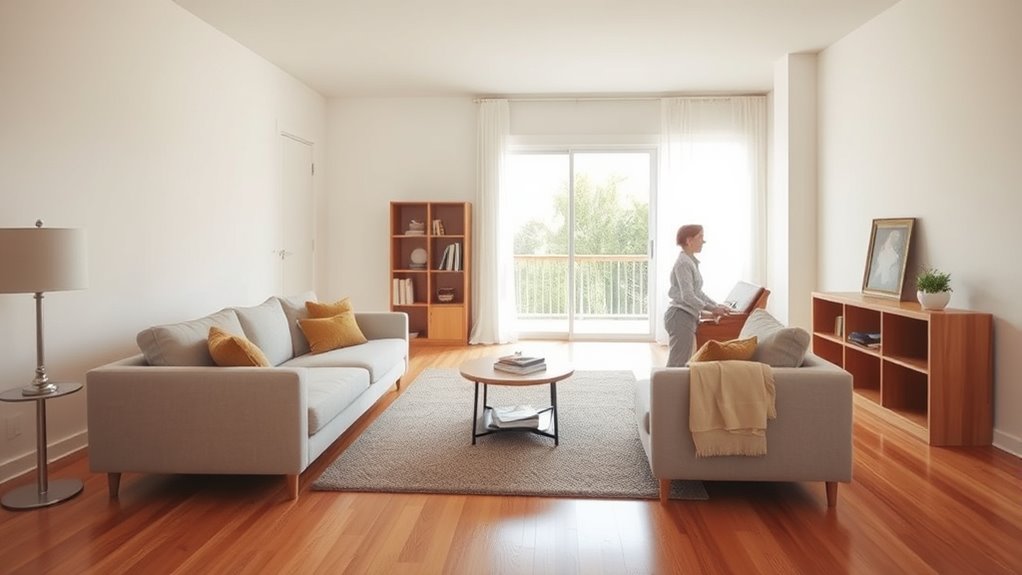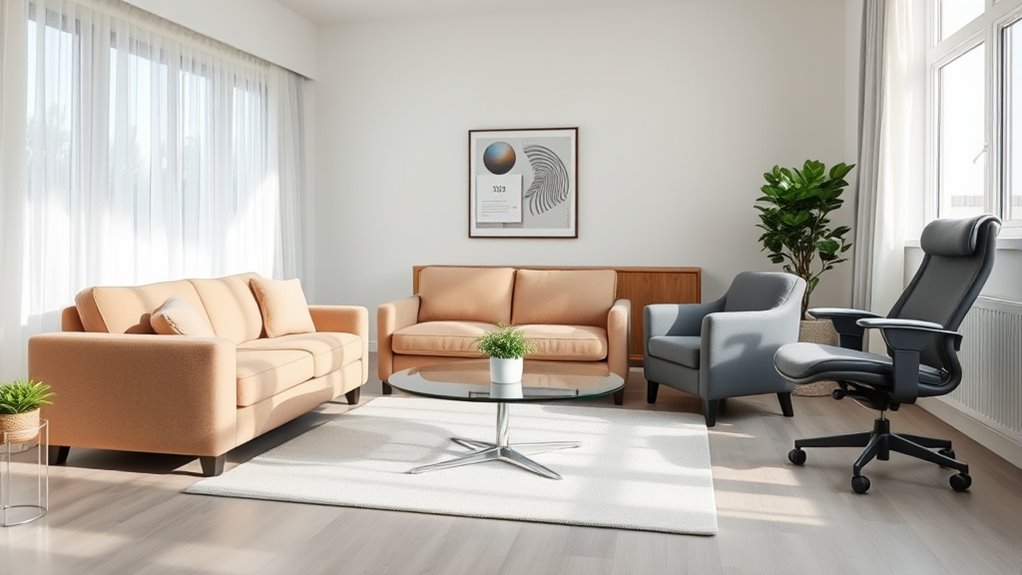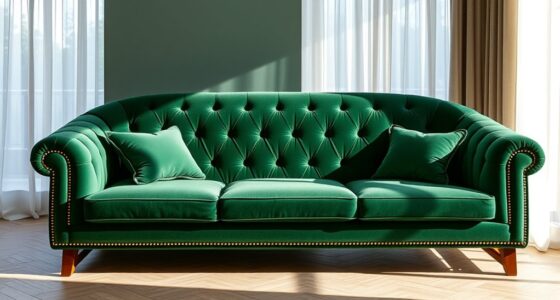To improve accessibility through furniture placement, keep pathways at least 36 inches wide and free of clutter, ensuring easy movement between key areas like the kitchen, bathroom, and bedroom. Position large furniture against walls and avoid blocking doorways or windows, creating smooth flow and safe navigation. Choose ergonomic pieces and keep frequently used items within arm’s reach. By optimizing space and reducing obstacles, you’ll create a safer, more comfortable environment—if you continue exploring, you’ll discover more helpful tips.
Key Takeaways
- Maintain wide, unobstructed pathways of at least 36 inches for easy navigation.
- Arrange furniture against walls to maximize space and prevent blocking doors or windows.
- Select ergonomic furniture and position frequently used items within arm’s reach.
- Place lighting near pathways and seating areas to improve visibility and safety.
- Use wall-mounted storage and keep clutter to ensure clear routes and promote independence.

Creating an accessible living space begins with thoughtful furniture placement that prioritizes ease of movement and safety. When you focus on space optimization, you guarantee that every piece of furniture serves a purpose without cluttering the room or creating obstacles. Properly arranged furniture allows you to steer your home comfortably, whether you use mobility aids or move freely without restrictions. To achieve this, you’ll want to contemplate the flow of the space, making sure pathways are wide enough—ideally at least 36 inches—to accommodate wheelchairs, walkers, or other assistive devices. This creates a seamless environment where you don’t have to squeeze past furniture or risk tripping over clutter.
Prioritize wide, unobstructed pathways of at least 36 inches for smooth, accessible movement throughout your home.
Ergonomic design plays a critical role in furniture placement, helping you maintain comfort and reduce fatigue. When selecting and positioning furniture, prioritize pieces that support your posture and are easy to reach. For example, placing frequently used items like remote controls, phones, or books within arm’s reach minimizes stretching or bending, which can be difficult or unsafe. Chairs and sofas should be sturdy with firm cushions, and tables should be positioned at appropriate heights to ease sitting and standing. Think about the height and placement of surfaces to promote better ergonomics, reducing strain on your body as you move through your space.
In terms of room layout, avoid blocking doorways, windows, or vents, which could hinder movement or access to natural light and fresh air. Instead, aim to create clear, direct pathways that connect key areas—kitchen, bathroom, bedroom—without sharp turns or narrow passages. When arranging furniture, consider using corner spaces efficiently, placing larger pieces against walls to free up central areas. This not only maximizes space but also prevents you from steering around bulky items that could be hazardous.
Lighting is another important aspect of furniture placement for accessibility. Position lamps or light fixtures near seating areas and along pathways to ensure visibility at all times. Good lighting reduces the risk of accidents and makes it easier to find items or read labels on furniture or appliances. When possible, incorporate adjustable lighting or motion sensors to enhance convenience and safety. Additionally, using wall organization systems with hooks and shelves can further enhance accessibility by keeping essential items within easy reach and reducing clutter.
Frequently Asked Questions
How Do I Measure My Space for Optimal Furniture Placement?
To measure your space for ideal furniture placement, start with a measuring tape to get accurate dimensions of each area. Create a floor plan by sketching your room’s layout, noting measurements and doorways. This helps you visualize where furniture will fit best. Measure the width and length of furniture pieces, then compare them to your floor plan. This way, you guarantee everything fits comfortably and flows well in your space.
What Colors Enhance Accessibility and Visibility in Furniture Arrangement?
When choosing colors to enhance accessibility and visibility, focus on color contrast and bright hues. Using contrasting colors between furniture and walls makes pieces stand out, guiding your eyes naturally. Bright hues like yellow or orange can boost visibility and create a lively atmosphere. You should select high-contrast combinations, such as dark furniture against light walls, to make sure everything is easy to see and navigate, improving safety and comfort.
How Can Furniture Be Adjusted for Different Mobility Aids?
Imagine a room where every piece of furniture invites easy movement. You can adjust furniture height and position, creating a seamless flow for mobility aids like wheelchairs or walkers. Incorporate adjustable furniture and mobility-friendly designs that allow you to customize spaces. This way, pathways stay clear, and access remains effortless, ensuring comfort and independence for everyone. Adapting furniture thoughtfully transforms your space into an inclusive, welcoming environment.
Are There Specific Furniture Styles Recommended for Accessibility?
When choosing furniture for accessibility, opt for ergonomic designs that support ease of movement and comfort. Minimalist styles are also beneficial because they reduce clutter and create open pathways, making navigation simpler. Look for pieces with clear, straight lines, and reachable heights. These styles help you move freely and access everything easily. Prioritize functionality over ornate features to ensure your space remains practical and accommodating for all mobility needs.
How Do I Maintain Accessibility as My Needs Change Over Time?
Think of your space as a living tree, growing and adapting over time. To maintain accessibility as your needs change, you should embrace adaptive strategies and future-proofing design. Regularly reassess your layout, choose versatile furniture, and stay open to modifications. This approach guarantees your environment evolves with you, supporting your independence and comfort, no matter how your needs shift. Stay flexible, and your space will continue to serve you well.
Conclusion
Mastering furniture placement for accessibility transforms your space into an unstoppable fortress of comfort and independence. With perfect arrangements, you’ll navigate your home like a superhero, dodging obstacles and conquering every room with ease. No more bumping into furniture or feeling trapped—your home becomes an unstoppable sanctuary of freedom. So go ahead, rearrange like a pro, and turn your living space into an invincible haven where accessibility reigns supreme!









